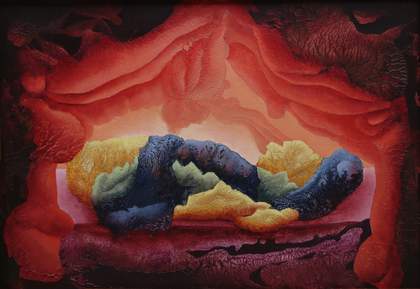
Ithell Colquhoun, Alcove, 1946, Private Collection © Spire Healthcare, © Noise Abatement Society, © Samaritans
One of the most radical artists of her generation, Ithell Colquhoun (1906-1988) was an important, but often overlooked figure in British surrealism. At Tate Britain following a run at Tate St Ives, this landmark exhibition is the largest of Colquhoun’s work ever staged, featuring over 130 paintings and drawings; many of which have never been publicly exhibited. The exhibition draws on Tate’s significant archive of the artist’s work, tracing the evolution of Colquhoun’s work from her early narrative paintings and engagement with the surrealist movement, to her fascination with the intertwining realms of art, sexual identity, ecology, magic and mysticism.
Following a loosely chronological path, the exhibition maps the influence of esoteric and surrealist concepts on the artist’s developing practice from the mid-1920s to the 1970s. Early paintings from her time at the Slade School of Fine Art will be presented, including Judith Showing the Head of Holofernes 1929, in which Colquhoun combines biblical subjects with fantastic architectural settings, already demonstrating her mystical interests.
The exhibition explores Colquhoun’s visual and conceptual engagement with surrealism in the 1930s and 40s. Botanical works such as Water-Flower 1938 show her evolving interest in a spiritual natural world. Colquhoun also became increasingly focused on representations of the human body through the surrealist ‘double image’ during this period, exemplified in Scylla (méditerranée) 1938, one of her most celebrated works, which merges the female form with the natural landscape. The exhibition offers the first chance to see Colquhoun’s storyboard for an unmade surrealist film titled Bonsoir 1939 in its entirety.
Tate Britain’s exhibition explores how Colquhoun engaged with the London art world through her exhibitions at the Mayor Gallery in 1939 and 1947 and offer an insight into Colquhoun’s contributions to surrealist concepts such as automatism. A turning point in her practice came in 1939 when she met Gordon Onslow Ford and Roberto Matta, who were using surrealist automatist techniques to create imagery through chance rather than conscious control. Their development of earlier surrealist ideas of automatism was intended to mine both the human psyche and other metaphysical realms. The exhibition explores how this approach became central to the evolution of Colquhoun’s intertwining artistic and occultist practice during the early 1940s when she moved away from traditional painting techniques. Her influential essay The Mantic Stain,1949 explored the spiritual possibilities of automatism, and the exhibition presents a group of paintings made using the decalcomania technique, involving the pressing together of two surfaces covered with paint to create a mirror image produced without the intentional use of the artist’s hand. Works such as Attributes of the Moon 1947 and Gorgon 1946 will show her preoccupation with channelling the spirit world. These works are shown alongside Colquhoun’s automatic experiments to demonstrate her process.
Colquhoun’s immersion in occultism developed increasingly into the 1940s, embracing ancient philosophical principles including alchemy, animism and mysticism, coupled with her own ideas about gender fluidity and interest in harnessing a divine feminine power. Her works in this period were full of magical symbolism, flowing energy channels and portals to extra dimensions Groups of works, such as a series entitled The Diagrams of Love 1940-2 reflect kabbalistic, tantric and alchemical ideas, portraying the merging of male and female forms to create an androgynous whole.
Colquhoun’s understanding of the world as a connected spiritual cosmos brought her to Cornwall from the early 1940s, where she was inspired by the region’s ancient landscape, Celtic mythologies, and neolithic monuments. Spending time between London and Cornwall, she acquired a studio in Lamorna on the Penwith peninsula in 1949 before settling in the nearby village of Paul. She published extensively: essays, surrealist novels and atmospheric travelogues including The Living Stones: Cornwall in 1957. Colquhoun’s fascination with the psychic histories of Celtic lands is evident in visionary works of sacred sites and standing stones in Cornwall and Brittany such as Dance of the Nine Opals 1942 and La Cathédrale Engloutie 1940, brought together in the exhibition for the first time.
The exhibition culminates with a section showcasing Colquhoun’s enamel drip techniques which the artist created during the final years of her life. This includes designs for a set of ‘Taro’ cards, an innovative series often considered the finest synthesis of Colquhoun’s art and magical practice, in which she departed from figuration altogether.
